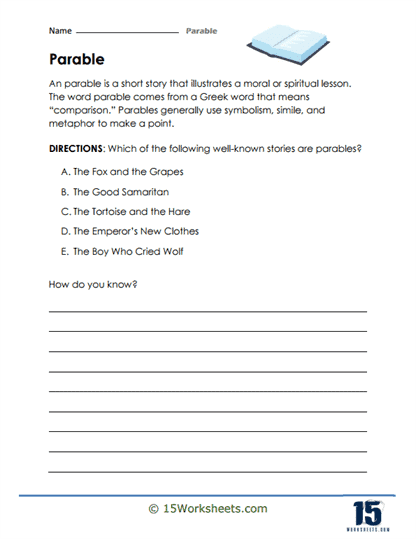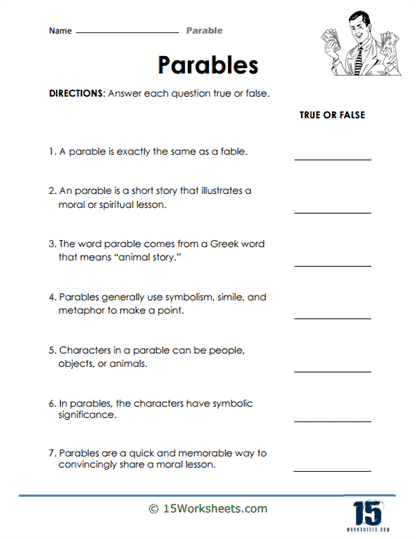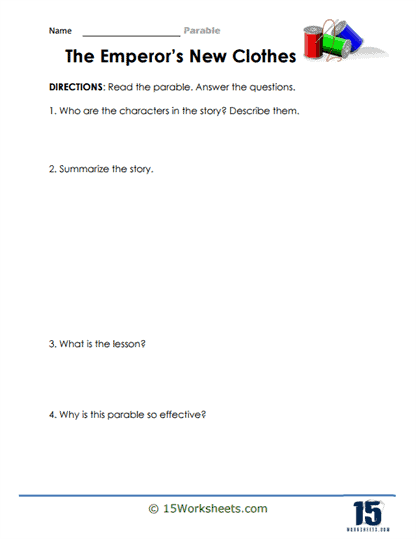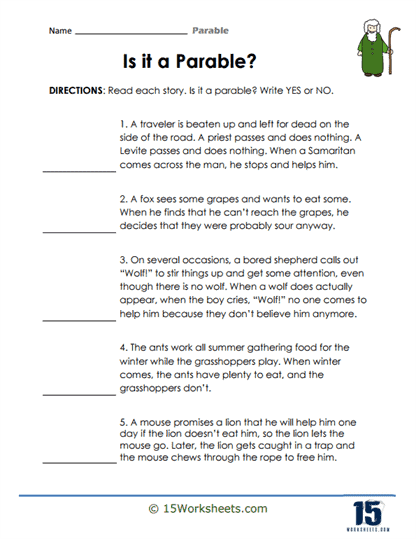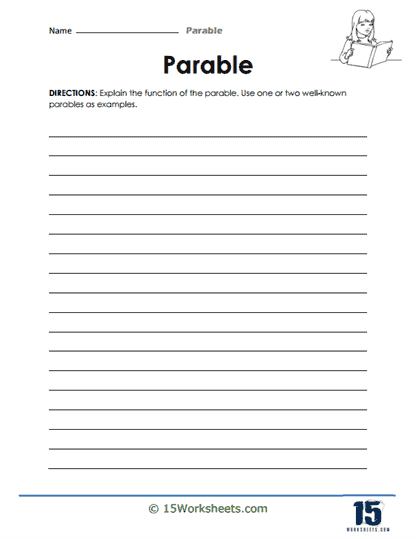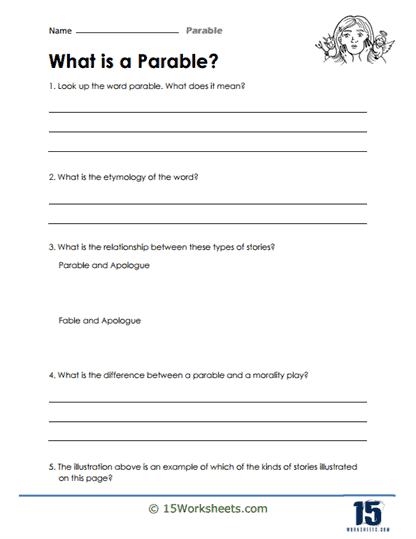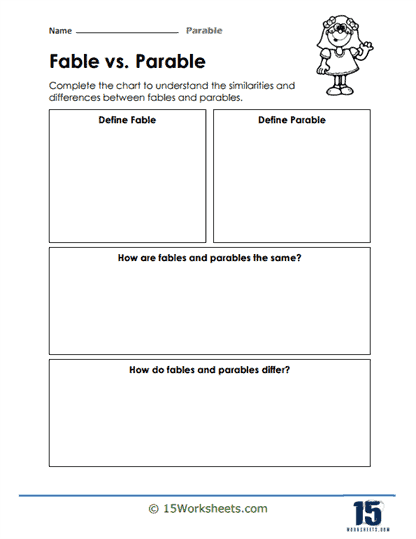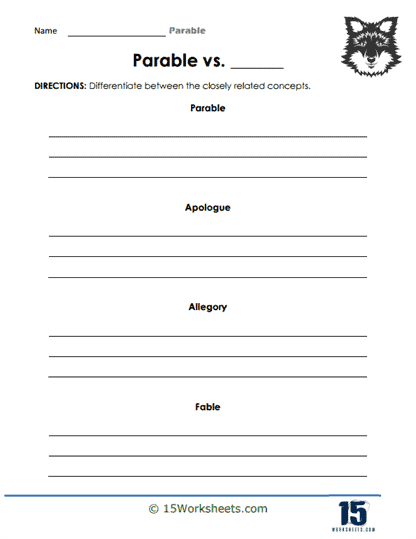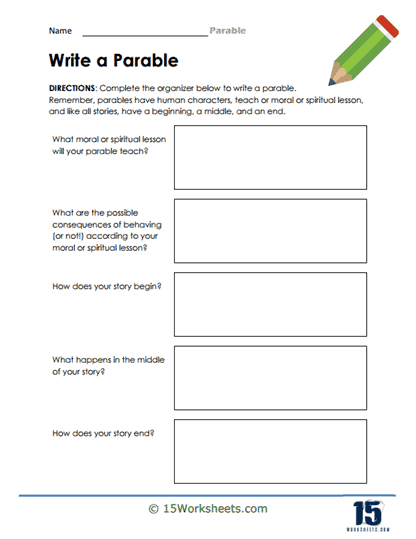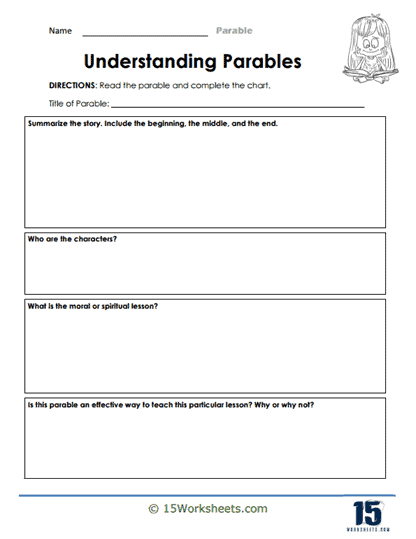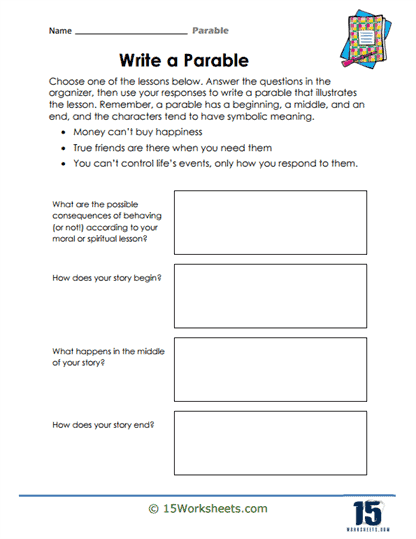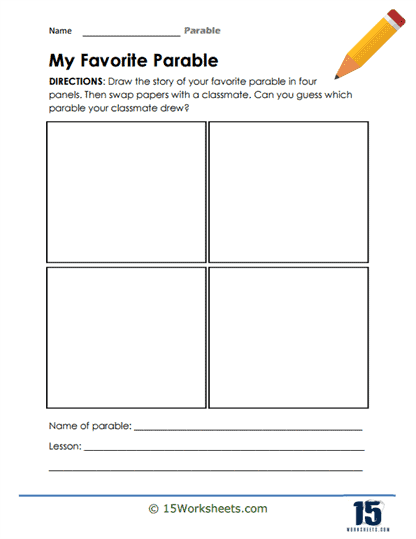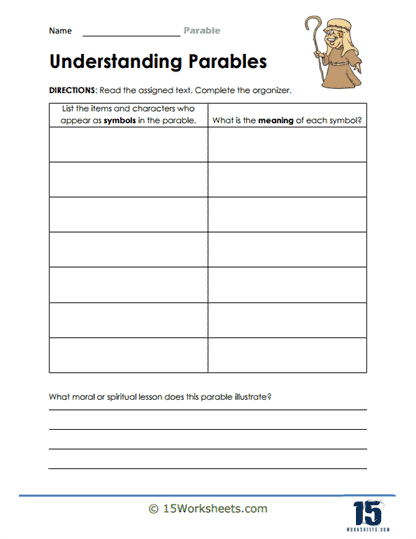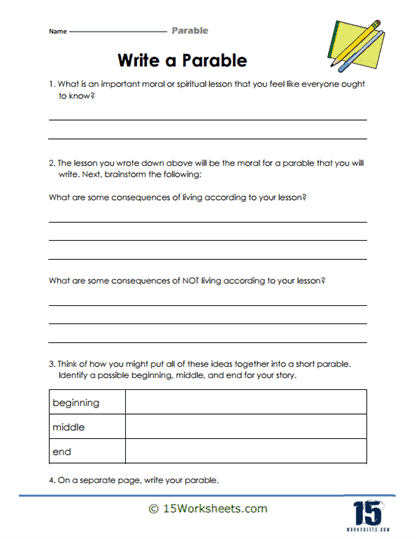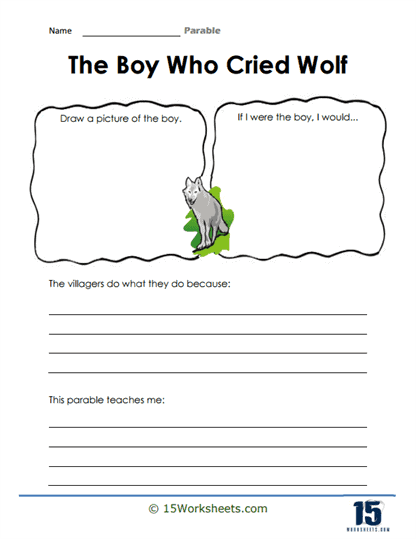Parable Worksheets
All About These 15 Worksheets
Parables, concise and allegorical stories with moral or spiritual lessons, are a rich and timeless literary form that transcends cultural and religious boundaries. Understanding parables is not only important for literary appreciation but also for fostering critical thinking, ethical reflection, and empathy. This collection of 15 worksheets is designed to introduce students to the world of parables, helping them grasp the importance of this narrative device, recognize its presence in various traditions, and apply its lessons to their own lives.
What Are Parable Worksheets?
A parable is a short, simple story that teaches a moral or a lesson. Think of it as a story that works like a metaphor, but instead of comparing two things, it teaches you how to behave or think. Parables often involve characters who are faced with moral dilemmas, or complicated problems that involve a question of what is right or wrong. They’re often found in religious texts, but are also used in more everyday settings.
These worksheets will help you learn to better understand and analyze parables. They include exercises like reading a parable and answering questions about it, or even writing your own parable! Here are examples of the types of work you can expect to see on our worksheets:
Reading Comprehension – This is where you’d read a parable and then answer some questions about it. For example, what is the main lesson of the story? Who are the main characters? What problem do they face?
Identifying the Moral – This would involve identifying the moral or lesson the parable is trying to teach. The moral is often not directly stated in the story, so you would need to infer it from the characters’ actions and the consequences they face.
Creative Writing – In these exercises, you might be asked to write your own parable. This would help you practice constructing a narrative and communicating a lesson or moral.
Discussion – These exercises would involve discussing the parable and its meaning with others. This could help you see different perspectives and deepen your understanding of the story.
Vocabulary Building – Some worksheets may have exercises that help build your vocabulary. You might have to find the meaning of certain words in the parable or use new words that you’ve learned in a sentence.
Art Integration – Sometimes, you might be asked to draw a picture or create a comic strip of the parable. This helps you understand the story better and makes learning fun!
Why Do Authors Use Parable As a Literary Device?
Parables are an incredibly unique and powerful literary device. A parable, in essence, is a simple, short story that illustrates a moral or instructive lesson. As a tool of teaching and conveying complex truths, parables are allegorical in nature and often employ symbolism to express moral, ethical, or spiritual ideas. The beauty of a parable is that it presents this instruction subtly, allowing the reader or listener to extract the intended lesson themselves, making it a more active and engaging learning process.
The defining feature of a parable is its purpose – to teach a lesson. This lesson is often not directly stated in the parable but can be inferred through the events of the story and the consequences faced by the characters. Parables also tend to be grounded in everyday life, using common situations or elements to illustrate their point, thereby making them relatable and easier for the reader to understand.
Authors use parables to convey complex ideas in a way that is accessible and engaging to the reader. The narrative form of the parable draws the reader in, while the moral lesson leaves them with something to think about long after they have finished reading.
Examples of Parables in Literature
“The Boy Who Cried Wolf” (Aesop’s Fables)
Aesop’s fables are a classic collection of parables, and “The Boy Who Cried Wolf” is one of the most well-known among them. In this parable, a shepherd boy amuses himself by tricking nearby villagers into thinking a wolf is attacking his flock. When the wolf actually does appear, the villagers ignore the boy’s cries for help, thinking it’s another false alarm. The moral of the story is not to lie – if you consistently tell untruths, people will doubt you even when you’re telling the truth. The events of the story and the consequences faced by the boy illustrate this lesson effectively, teaching readers about the dangers of dishonesty in a way that a straightforward instruction could not.
“The Parable of the Prodigal Son” (The Bible)
The Bible is filled with parables, particularly in the New Testament. The “Parable of the Prodigal Son” from Luke 15:11-32 tells the story of a young man who asks his father for his inheritance, leaves home, and squanders his wealth in a far country. When he returns home destitute, his father welcomes him back with open arms. The elder brother, who stayed with the father, is envious of the attention his younger brother received. The father explains that they should celebrate because the prodigal son was lost but now is found. The parable teaches about the nature of forgiveness and unconditional love, showing that it’s never too late to return home and make amends.
“The Pearl” (John Steinbeck)
“The Pearl” is a novel but can be read as an extended parable. The story follows a poor pearl diver named Kino who finds a great pearl. Believing the pearl will bring his family out of poverty, Kino begins to dream of the future. However, the pearl brings misfortune and tragedy instead, leading Kino to throw the pearl back into the sea. The story is a parable of the dangers of wealth and the destructive power of greed. It teaches that material possessions and wealth aren’t always a blessing and that one must be careful not to lose sight of what truly matters.
Through these examples, we can see how parables allow authors to engage with readers and impart important lessons. By combining storytelling and teaching, parables create a more active and thought-provoking reading experience. They allow readers to engage with the text, reflect on their own experiences, and gain new insights into human behavior and moral choices.
Benefits Of Parable Worksheets For Students
Exploring the world of parables through this collection of 15 thought-provoking worksheets offers students an opportunity to develop essential skills in moral and ethical reflection, literary analysis, cultural awareness, critical thinking, empathy, and compassion. Parables are timeless narratives that convey profound wisdom and moral lessons, making them a valuable tool for exploring the complexities of human behavior and values.
By engaging with these exercises and activities, students not only enhance their academic abilities but also gain valuable tools for ethical decision-making, literary exploration, and cultural understanding. The benefits of studying parables extend far beyond the classroom, empowering students to be more thoughtful, empathetic, and culturally aware individuals in an increasingly interconnected world.

